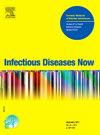留尼汪岛2020 - 2022年阴道毛滴虫流行、临床表现及危险因素分析
IF 2.2
4区 医学
Q2 INFECTIOUS DISEASES
引用次数: 0
摘要
目的阴道单胞菌(TV)是一种鲜为人知的性传播感染(STI),感染者会出现并发症。在留尼旺岛缺乏数据的情况下,我们的目的是估计TV的患病率,并研究与这种感染相关的危险因素和临床症状。方法选取留尼旺岛大学医院(UH)和STI中心(CeGIDDs)于2020年1月至2022年12月期间进行电视检测的所有人员。根据对从生殖器、肛门或口咽部位收集的样本进行多重PCR检测的结果,估计了电视患病率。结果在17,261份样本(来自13,847名患者)中,310例TV阳性(30例来自CeGIDDs, 280例来自UH),总体TV患病率为2.20% (95% CI: 1.99-2.49)。CeGIDDs (n = 3,733)的TV患病率为0.80% (95% CI: 0.52-1.10), UH (n = 10,114)的TV患病率为2.80% (95% CI: 2.45-3.09)。在CeGIDD人群中,女性电视患病率为1.15% (95% CI: 0.71-1.8),而男性为0.47% (95% CI: 0.22-0.90)。电视与不稳定性有统计学显著相关(aOR 3.13, 95% CI: 1.46-6.46), 23.3% (7/30, 95% CI: 8.20-38.47)的电视阳性患者有症状。结论与其他国家相比,留尼旺岛是电视低风险地区之一。它的存在与恶劣的生活条件和缺乏临床症状有关。本文章由计算机程序翻译,如有差异,请以英文原文为准。
Prevalence, clinical Presentation and risk factors for Trichomonas Vaginalis in Reunion Island between 2020 and 2022
Objectives
Trichomonas vaginalis (TV) is a little known sexually transmitted infection (STI) that presents complications for infected individuals. In the absence of data in Reunion Island, our aim was to estimate the prevalence of TV and to study the risk factors and clinical signs associated with this infection.
Method
Between January 2020 and December 2022, all persons tested for TV at the University Hospital (UH) and STI centres (CeGIDDs) of Reunion Island were included in this study. TV prevalence was estimated based on the results of the multiplex PCR tests on samples collected from genital, anal or oropharyngeal sites.
Results
Out of the 17,261 samples (from 13,847 patients) included, 310 were positive for TV (30 from CeGIDDs and 280 from UH), representing overall TV prevalence of 2.20 % (95 % CI: 1.99–2.49). The prevalence of TV was 0.80 % (95 % CI: 0.52–1.10) in CeGIDDs (n = 3,733) and 2.80 % (95 % CI: 2.45–3.09) in UH (n = 10,114). In the CeGIDD population, prevalence of TV was 1.15 % (95 % CI: 0.71–1.8) for women, compared with 0.47 % (95 % CI: 0.22–0.90) for men. TV was statistically significantly associated with precariousness (aOR 3.13, 95 % CI: 1.46–6.46), and 23.3 % (7/30, 95 % CI: 8.20–38.47) of TV-positive patients had symptoms.
Conclusion
Compared to other countries, Reunion Island is one of the lower-risk areas for TV. Its presence is associated with poor living conditions and a paucity of clinical signs.
求助全文
通过发布文献求助,成功后即可免费获取论文全文。
去求助
来源期刊

Infectious diseases now
Medicine-Infectious Diseases
CiteScore
7.10
自引率
2.90%
发文量
116
审稿时长
40 days
 求助内容:
求助内容: 应助结果提醒方式:
应助结果提醒方式:


